This article discusses how digital advertising influences digital commerce, highlighting real-world examples of marketers using various strategies to achieve their goals.
We provide practical tips to enhance performance with advanced e-commerce tools. Notably, AI integration in online shopping led to a 4% increase in holiday sales in 2024, showcasing how innovations affect consumer behavior.
To succeed in the digital marketplace, it’s important to understand the pros and challenges of e-commerce. By leveraging the right tools, you can turn obstacles into growth opportunities with SmartyAds.

What is e-commerce
Over the last few years, e-commerce has become an integral part of global retailing, and its role continues to grow yearly. Along with many other industries, the buying and selling of goods have undergone significant changes since the advent of the Internet market. It has provided new technologies and opportunities for new forms of commercial relationships previously impossible in the real world.
Today, the digitalization of modern life allows consumers worldwide to enjoy the benefits of online shopping. With increasing Internet access, more people are shopping online, enjoying the convenience of 24/7 access from home. They can compare products and prices easily, creating opportunities for merchants to reach a broader audience and offer their products globally.
Before 2020, the development of e-commerce was influenced by the growth in the number of active users, improvement in their shopping experience, increased trust in online stores, and investment by major players in ecommerce advertising and infrastructure. The pandemic added to these factors:
- a restriction on offline shopping;
- the move to remote work and the associated outflow of people from major cities;
- increased demand for food delivery.
Consumers had no choice but to shop online. During the isolation, many people got used to this kind of shopping.
Experts estimate that e-commerce retail sales worldwide will exceed $8.1 trillion by the end of 2024, which is only expected to grow in the coming years. This shows that e-commerce is one of the fastest-growing sectors of the global economy. Most people now shop online to buy everything from clothing and electronics to food and home goods in some e-commerce stores.
Benefits of e-commerce
All benefits have drawbacks, and it's always about two sides of the same coin. However, limiting your company in e-commerce means disappearing from people's minds. A thoughtful approach to monetizing through digital marketing will help you improve your profits and avoid challenges ahead of you now and in the future.
Saving time and money
E-commerce has a fairly low entry threshold: you can quickly start an ecommerce business with minimal financial investment. There is no need to rent premises or hire a whole staff to work on the Internet. Many tasks can be entrusted to computer programs (processing applications, collecting information, accepting payments, etc.). E-commerce marketing is also less expensive.
A wide target audience
World Wide Web is used daily by millions of people worldwide. Properly configured e-commerce advertising lets you easily find customers interested in your products.
Detailed analytics
Analytical tools of advertising platforms collect important information about your audience and combine it into clear reports. Where your customers came from (advertising platform, search engine, or other channels), what products they were looking for, what browser they use to enter the web — this and other information can make your ecommerce business more effective.
For example, you can calculate the cost of attracting a customer and understand whether digital marketing costs are paying off.
Convenience for customers
Unlike conventional retail outlets, an ecommerce store can operate 24/7: the customer can go to an online store anytime, see products, and place an order right from home.
Extensive opportunities for development
E-commerce is expanding year by year, and people are getting used to shopping online. Services for online commerce are being introduced: electronic payment systems, mail-outs, CRM, SaaS, etc. The business has great potential for the development and promotion of the brand.
However, along with the rapid development of e-commerce comes new challenges.
Challenges of e-commerce
E-commerce is a stable and already formed niche that continues to develop and promises to maintain sustainable growth for many years. This also means that all the challenges have been answered and response algorithms developed, so when researching obstacles, we should only focus on ways to overcome them. Some of the major challenges include:
Security
One of the most significant challenges of e-commerce is security. Cybercriminals constantly seek ways to exploit vulnerabilities in e-commerce platforms, stealing personal and financial information from consumers. This can lead to identity theft, credit card fraud, and other financial crimes. E-commerce businesses must take steps to ensure the security of their platforms and protect their customers' data.
Competition
E-commerce has opened up new opportunities for businesses to reach a wider audience but has also increased competition. With so many businesses operating online, it can be challenging for new and existing businesses to stand out and attract customers. Businesses must have a unique value proposition and use digital marketing strategies to differentiate themselves from competitors.
Logistics
Shipping and handling can be a significant challenge for e-commerce businesses, particularly those that sell physical products. Shipping costs can be high, and customers expect fast and reliable delivery. E-commerce businesses must have an efficient and reliable logistics system in place to ensure that products are delivered quickly and cost-effectively.
Returns and refunds
E-commerce businesses must also deal with returns and refunds, which can be costly and time-consuming. Customers expect hassle-free returns and refunds, and businesses must have a clear policy in place to handle these situations.
Customer service
E-commerce businesses must provide excellent customer service to compete in a crowded online marketplace. This includes responding quickly to customer inquiries, providing accurate information about products and services, and resolving issues promptly and professionally.
However, various digital marketing tools can cope with the challenges of e-commerce, which can minimize risks or compensate for deficiencies in any area of your business. One such tool is advertising.
Ecommerce Advertising Strategies
Advertising and digital marketing are vital for e-commerce businesses. They help attract customers, build brand awareness, and increase sales. In such a competitive market, effective online advertising is essential for reaching the right audience and achieving sales goals.
How to make a good ecommerce advertising strategy
Ecommerce advertising encompasses a variety of strategies and techniques that online businesses employ to promote their products or services to potential customers. It's a crucial aspect of e-commerce, as effective advertising helps companies attract new clientele, boost brand recognition, and drive sales. Here are some useful tips for enhancing your ecommerce marketing efforts:
Use Paid Search Advertising
Paid search advertising is one of the best ecommerce ads types. It involves placing ads on search engine results pages (SERPs) for specific keywords. Businesses bid on relevant keywords to their products or services, and their ads appear at the top or bottom of the search results page. This type of advertising is commonly used by e-commerce businesses to drive traffic to their online store and increase sales.
Implement Shoppable Ads
Platforms like Instagram, Facebook, and Pinterest now offer shoppable ad formats, allowing customers to purchase directly from the ad. This seamless shopping experience reduces friction and increases conversions.
Use Social media advertising
One of the top strategies in e-commerce marketing is social media advertising. This approach involves placing ads on platforms like Facebook, Instagram, Twitter, and LinkedIn. These ecommerce advertising can be tailored to target specific demographics, interests, and behaviors, making them a powerful tool for reaching potential customers. Social media advertising is especially beneficial for e-commerce businesses that offer visually appealing products since it allows them to showcase their items in an eye-catching way.
Use Display advertising
Display advertising involves placing banner ads on websites, typically in the form of images or videos. These ads can promote your website well as they target specific audiences based on their interests and behavior, making them an effective way to reach potential customers. Display advertising is often used by e-commerce businesses to build brand awareness and promote new products.
Use Email marketing
Email marketing involves sending promotional messages to a targeted list of subscribers. E-commerce businesses can use email marketing to promote new products, sales, and other promotions to their existing customers. This type of advertising is particularly effective for e-commerce businesses with a strong email list, as it allows them to reach their customers directly.
Leverage User-Generated Content (UGC)
UGC, such as reviews, social media posts, and testimonials, enhances trust and authenticity. Encourage customers to share their experiences and incorporate their content into e-commerce ads. Statistics show that UGC-based ads have a 4x higher click-through rate than traditional ads.
Run an Affiliate Marketing Program
Collaborate with influencers, bloggers, and affiliates to expand your reach. Offering a commission-based structure incentivizes partners to promote your products, driving traffic and conversions while minimizing upfront ad spend.
Run an influencer marketing campaign
Influencer marketing involves partnering with social media influencers to promote products or services to their followers. Ecommerce businesses can run influencer marketing campaigns with influencers with a strong niche following to reach potential customers and promote their products. This type of advertising is particularly effective for ecommerce ad campaigns that sell niche products or have a unique value proposition.
Use personalization
Personalization is a crucial aspect of digital marketing for ecommerce businesses. Businesses can increase customer engagement, loyalty, and sales by personalizing emails, ecommerce site content, product recommendations, advertising, social media content, and user-generated content to the customer's interests and preferences.
Utilizing data such as browsing and purchase history, businesses can recommend products and content that are most relevant to the customer, increasing the likelihood of a purchase.
Personalization also ensures more precise targeted advertising, increasing conversion chances. Businesses can ultimately drive growth and success by tailoring marketing messages and ecommerce marketing campaigns to the customer.
Examples of the Best Ecommerce Marketing Campaigns
Let's look at a few of the best e-commerce advertising examples in digital marketing history. Perhaps they will inspire you or give you a better understanding of how a well-chosen strategy can work.
Uber
In 2018, Uber introduced the #BeyondFiveStars campaign to highlight the unique and beautiful connections that form between passengers and drivers. As part of this initiative, Uber encouraged its customers to share their remarkable stories about their experiences with drivers on social media, using the hashtag #BeyondFiveStars.
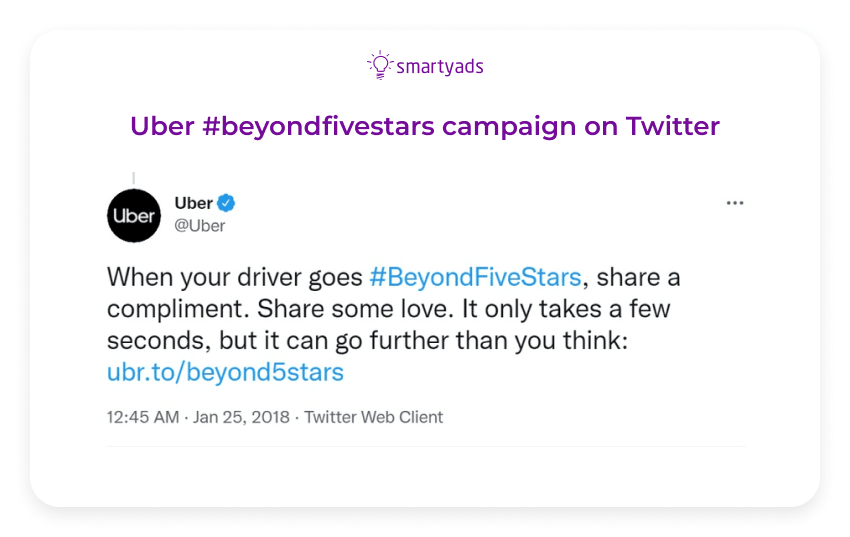
Several of the most touching stories were selected by Uber and turned into videos that illustrate how such chance encounters can lead to remarkable relationships. One such story is that of Uber driver Fred, who, thanks to his job, met his favorite celebrity, the famous American singer Pat Boone.
The #BeyondFiveStars campaign draws attention to interesting stories from Uber customers and their drivers and reminds passengers that they can leave compliments for their drivers using the "Compliments" feature.
This feature lets passengers rate their drivers and let them know that they appreciate their hard work and effort and the drivers' kindness and attention.
Ultimately, the #BeyondFiveStars campaign reminds us of the importance of kindness and respect for others and emphasizes that small actions and gestures can lead to real miracles and even change people's lives.
BarkBox
Personalization is one of the key marketing ecommerce marketing ideas, and BarkBox, BARK's dog toy subscription service, excels in this area. Through its No Dog Left Behind program, the company engages about a third of its monthly customers to gather insights about their dogs' habits. This data helps BarkBox tailor its product offerings, enhancing customer satisfaction and loyalty.
BarkBox also demonstrates creativity in its social media campaigns, effectively capturing the attention of its audience. For example, the brand has turned "National Squirrel Day" into a social media event, with squirrels amusingly taking over its accounts every January 21 to share memes and generate buzz. This clever approach not only raises brand awareness but also drives sales.
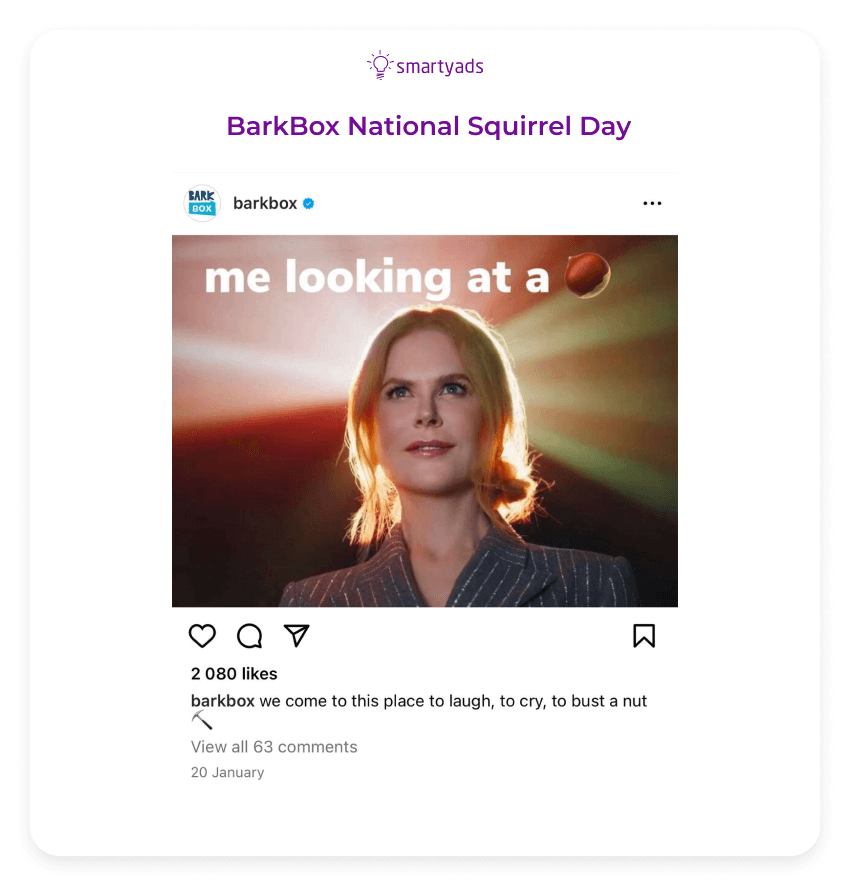
Mothercare
Mothercare, a global leader in clothing and products for moms and babies, knows that new mothers face serious body image issues after giving birth because of unrealistic beauty standards set by society. In response to this problem, the company has launched a unique and innovative #BodyProudMums ecommerce marketing campaign that promotes positive body awareness and helps young mothers take pride in their bodies.
To achieve this goal, Mothercare worked with 10 young mothers to help them create impactful and inspiring images, which were then distributed throughout the company's offline and online channels. Moreover, Mothercare encouraged its audience to share their stories on social media platforms using the hashtag #BodyProudMums. In this way, the campaign gave a voice to young mothers struggling with body image issues, and thousands of social media users shared their stories, leading to the campaign going viral.
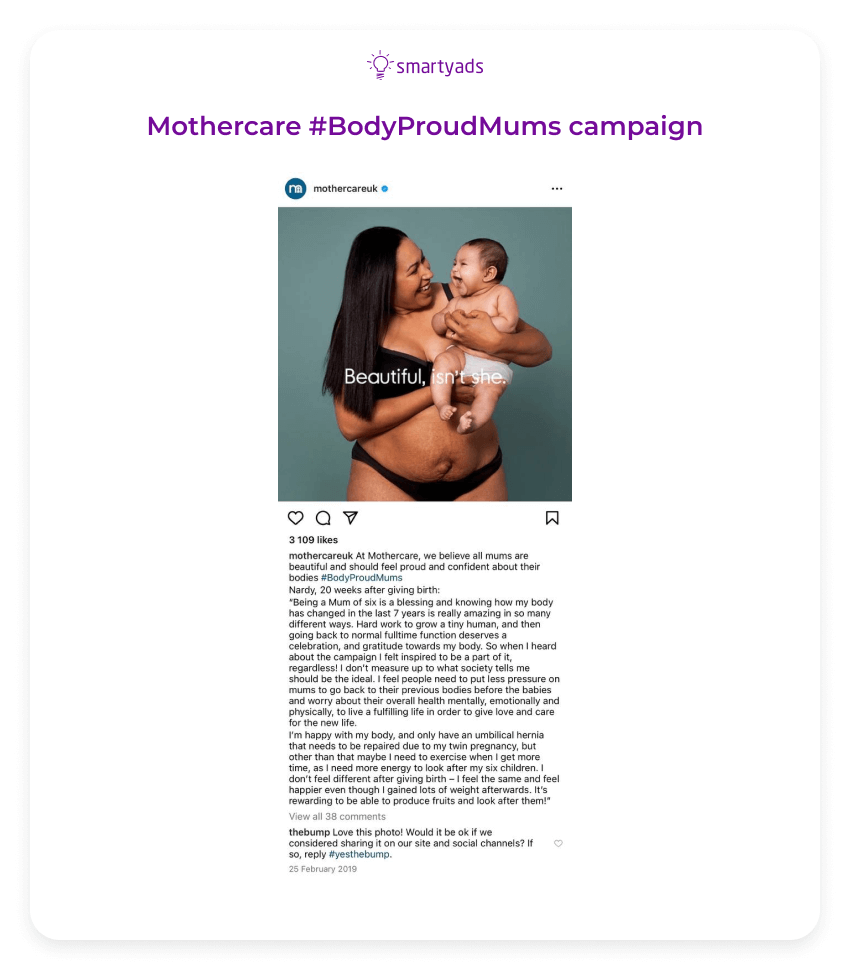
As a result, the campaign received more than 1 billion impressions and increased the brand's audience engagement by 18%. It was a powerful ecommerce marketing strategy and an important message that beauty is not just about looks but also about health, happiness, and confidence that mothers can pass on to their children.
And some more great examples of the best e-commerce marketing campaigns
We have collected even more examples of campaigns guided by the following principle. In one form or another, these ideas have been inherited by smaller brands and, after transforming, implemented in countless ad marketing creatives.

Best Ecommerce Marketing Campaigns
Oscar Mayer
Oscar Mayer, a legendary sausage producer in the United States, joined a group of highly skilled Korean beauty experts, Seoul Mamas, to create a unique face mask that was inspired by the world's most iconic food product, bologna sausage. However, while unusual, the idea of using the shape and packaging of sausage to create the mask was ingenious. This ambitious approach allowed them to create an innovative product that immediately gained popularity.
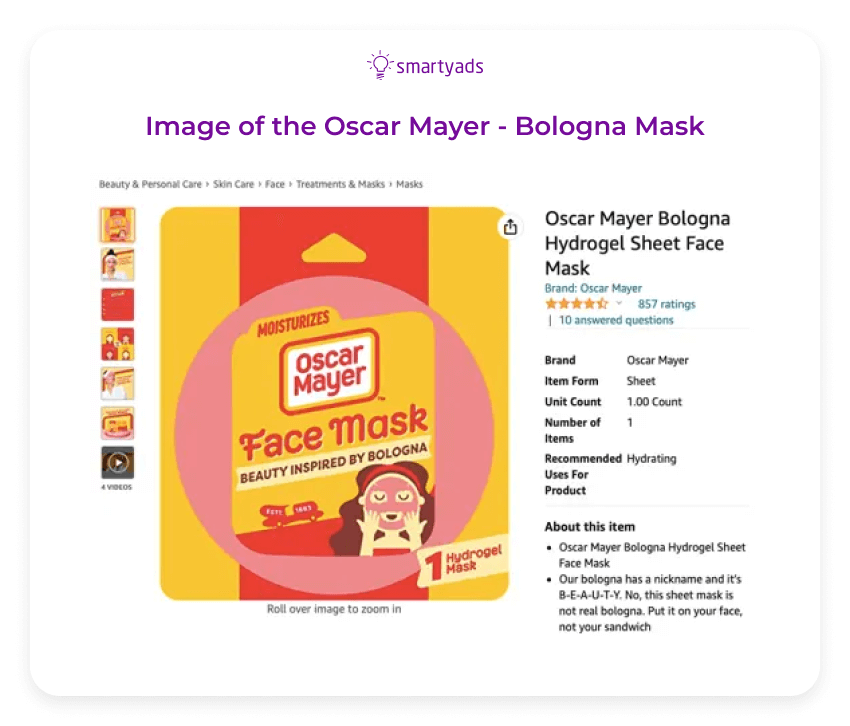
The face mask, designed using the shape and packaging of bologna sausage, appealed to an entire generation of people who grew up enjoying the taste of this unique product, playing with its slices, and remembering it as something that was always in the house. Using these elements that have been firmly embedded in our culture has created a product that has evoked nostalgia and an emotional response in many people.
Thanks to all these innovations, the mask became a quick visual joke, perfect for social media user-generated content, which immediately attracted the attention of users worldwide. It became a model of technical and creative genius and a symbol of how an idea seemingly incompatible with the beauty world can become a successful and promising product.
Duolingo
Duolingo is not just an online language course but one of the most influential brands in TikTok and social media, targeting a Generation Z audience. They create content that grabs the attention of millions of users and turns language learning into a fun process.
The brand introduces the owl mascot Duo, who has become an iconic figure and one of the most recognizable characters on social media. It appears in silly but hilarious music videos about language translation and pop culture, emphasizing that learning languages is useful and fun.
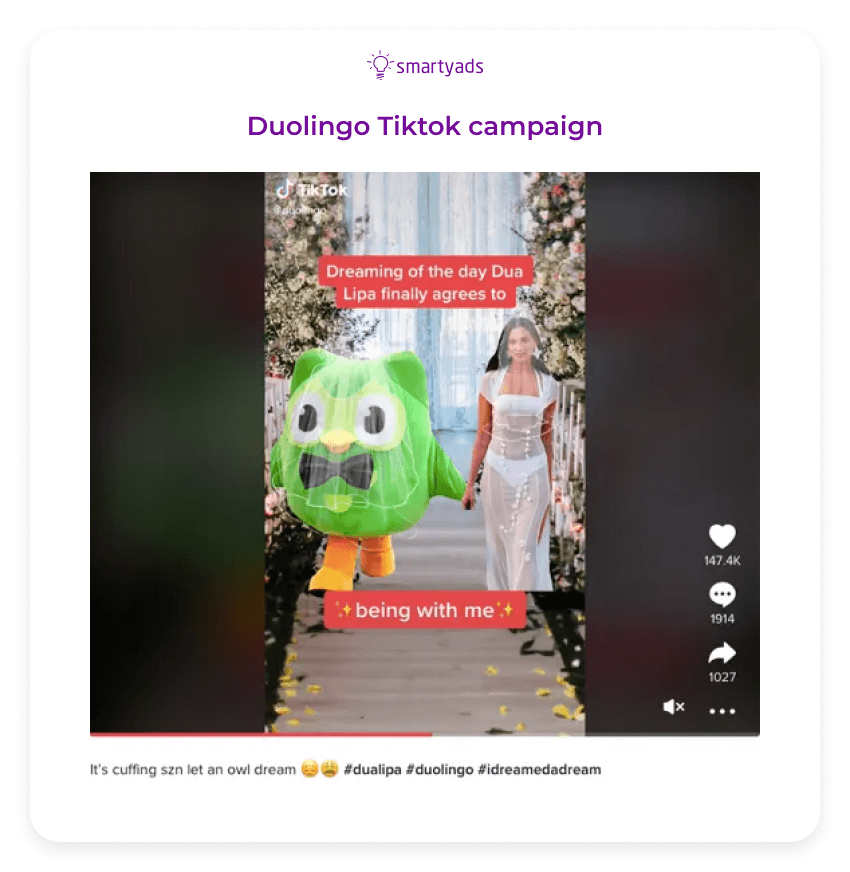
Duolingo also mocks its main competitor, Google Translate, and demonstrates the superiority of its technology and learning methodology. This adds humor and fun to the content, demonstrating how Duolingo stands out in the online language course market and is the first choice for many users.
Thanks to its original and funny content, Duolingo has attracted more than 5.3 million subscribers on TikTok, and its videos have received more than 106 million likes. It has become not just a popular brand on social media but a sign that says language learning can be fun and accessible for everyone. Duolingo is a true leader in its field and shows how social media marketing can be effective and unique.
Firehouse Subs
Firehouse Subs is celebrating its seventh year of continuously rewarding its members for their activity and brand loyalty. The company launched Rewards Week to celebrate the occasion, which lasted seven days and provided exclusive offers and reward points for its app users.
During the week, the brand posted tips and details about where users could find bonus points for their accounts. This generated much interest and interaction from the brand's fans, who passionately followed the news and additional bonuses.
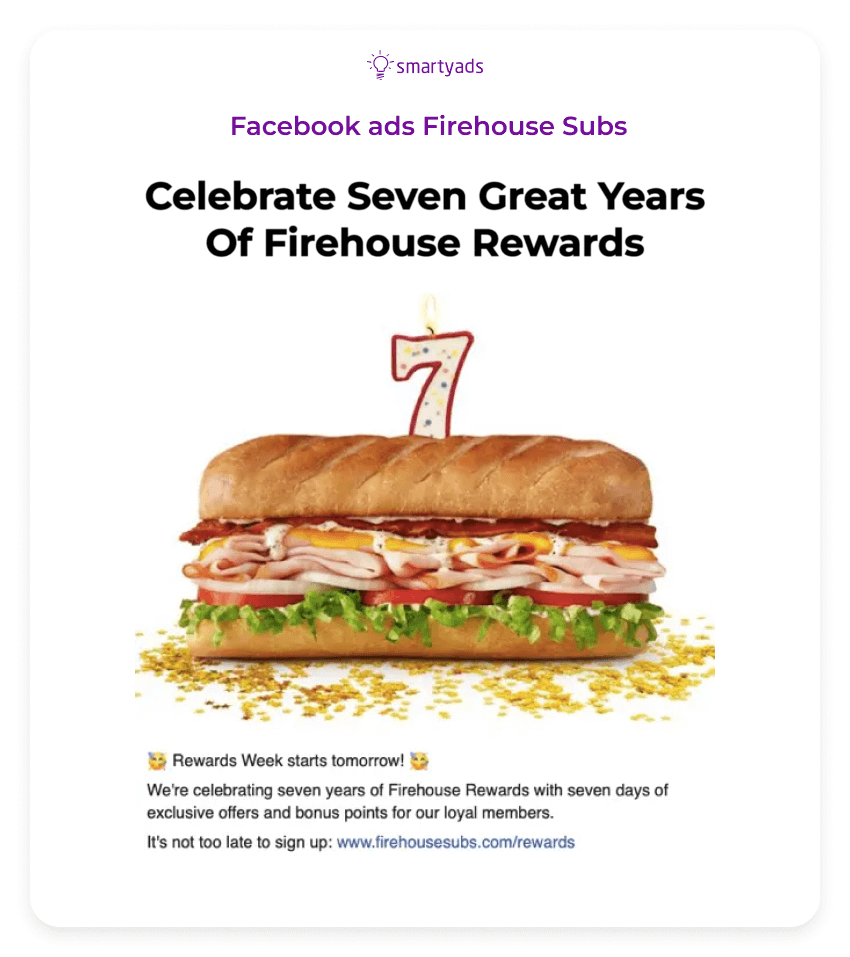
The social media posts created in honor of Rewards Week were styled after Firehouse Subs' corporate design and highlighted popular menu items and app features. They also encouraged users to actively use the Firehouse app and participate in the promotion.
As a result, Rewards Week was a great success for the company, attracting many new users to the app and keeping existing members active and loyal. Firehouse Subs continues to lead the fast food industry through innovative marketing strategies and constant attention to its audience.
Best E-commerce Ad Platforms
Nowadays, there are a large number of tools that allow you to create digital ecommerce marketing campaigns even with a modest investment. But they also allow you to create the large-scale ecommerce campaigns that big brands need. In this section, we'll talk about platforms that allow you to do both.
SmartyAds
Speaking of advertising platforms, we can't help but mention our SmartyAds DSP because we created it with the modern demands of brands in mind. We tried to make our platform as relevant and user-friendly as possible for marketers.
Our platform uses machine learning algorithms to optimize ad campaigns in real time, targeting specific audiences based on their behavior, interests, and demographics.
SmartyAds DSP platform also provides advanced analytics and reporting tools to help advertisers measure their campaign performance and make data-driven decisions. Additionally, it offers a user-friendly interface, excellent customer support, and integration with other advertising tools and platforms.
Google Ads
Google Ads is the most popular and widely used advertising platform globally. It offers a wide range of advertising options, including search, display, shopping, and video ads. You can target users based on their search queries, location, demographics, interests, and behavior. Google Ads also provides a variety of tools to help you optimize your ecommerce marketing campaigns and improve your ROI.
Facebook Ads
With Facebook's advertising platform, you gain access to a diverse selection of ad formats, ranging from compelling image ads to engaging video ads and interactive carousel ads. Leverage the platform's advanced targeting capabilities to reach users based on their interests, behaviors, and demographics. Additionally, retarget users who have previously shown interest in your business. Harness the power of Facebook Ads' robust analytics tools to monitor and analyze your campaign performance, empowering you to make informed decisions based on valuable data insights.
Instagram Ads
Instagram is a popular social media platform that's particularly popular among younger demographics. Its advertising platform allows you to create visually appealing ads in the form of images, videos, or stories. You can target users based on their interests, behavior, and demographics, and you can also retarget users who have engaged with your business in the past.
Amazon Advertising
Amazon is the world's largest online retailer, and its advertising platform allows you to promote your products to millions of users. Amazon Advertising offers a variety of ad formats, including sponsored product ads, sponsored brand ads, and display ads. You can target users based on their search queries and behavior on Amazon, and you can also use Amazon's analytics tools to measure your campaign performance.
Pinterest Ads
Pinterest is a visual discovery platform that's particularly popular among users interested in fashion, home decor, and DIY projects. The advertising platform empowers you to create promoted pins that seamlessly appear in users' feeds. You have the ability to target users based on their interests, ensuring your ads reach a relevant audience. Moreover, you can retarget users who have previously engaged with your business, enhancing the effectiveness of your campaigns. Leverage the platform's capabilities to optimize the impact of your promoted pins and effectively connect with your target audience.
Snapchat Ads
Snapchat is a popular social media platform among younger demographics. Its advertising platform allows you to create video ads that appear in users' stories. You can also use Snapchat analytics to precisely track the effectiveness of your campaign and target users based on their interests.
TikTok Ads
TikTok is a short-form video platform that's rapidly growing in popularity despite all the government restrictions. Its advertising platform allows you to create engaging video ads that appear in users' feeds. TikTok is famous for its personalization algorithms, so its analytics and ad campaign setup algorithms are just as good.
LinkedIn Ads
LinkedIn is a professional networking platform that's particularly popular among B2B businesses. Its advertising platform allows you to create sponsored content and ads that target specific industries or job titles.
Twitter Ads
Twitter is a popular social media platform ideal for e-commerce businesses targeting specific demographics or interests. Its advertising platform allows you to create promoted tweets and ecommerce marketing campaigns that reach users based on their interests and behavior. Thanks to a large set of analytical tools, Twitter also provides ample opportunities to test and customize your campaigns.
YouTube Ads
YouTube is the world's second-largest search engine after Google, making it a powerful platform for e-commerce businesses. Its advertising platform allows you to create video ads that appear before or during users' video content. YouTube also has a pretty good targeting system that will allow you to accurately customize your campaigns.
Bottom line
In conclusion, the foundation of any successful ecommerce marketing campaign lies in meticulous planning and the strategic selection of advertising platforms. Each platform comes with its unique strengths and limitations, so a thoughtful assessment of your goals, audience, and budget is essential to make informed decisions that maximize impact.
A well-executed ecommerce launch campaign can set the tone for long-term success in the digital marketplace. Crafting compelling ad content that resonates emotionally and targeting audiences with precision are the cornerstones of meaningful engagement. By embracing advanced analytics, businesses gain invaluable insights to continuously optimize performance, ensuring every dollar spent contributes to measurable growth.
Take the first step toward measurable success—launch your ecommerce marketing campaign with SmartyAds and unlock your brand's potential.

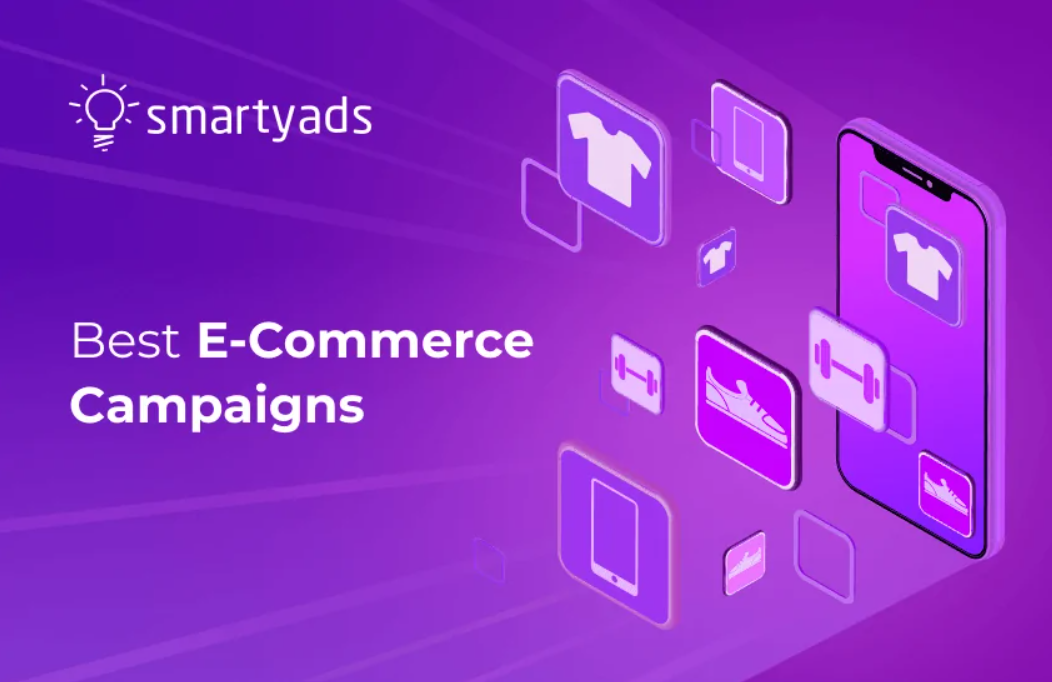



![In-App Advertising: the Complete Guide [Updated 2025]](/storage/uploads/2020/september/in-app-advertising-trends.png)